Singleton 40-Year-Old Malt Whisky: a Majestic Malt
Critics and writers might occasionally complain about the march to limited edition spirits and ancient whiskies, seemingly at the expense of the everyday releases, but you can be sure that secretly, we all love the opportunity to try these incredible treasures.
The latest to come my way is the amazing Singleton 40-Year-Old malt whisky.
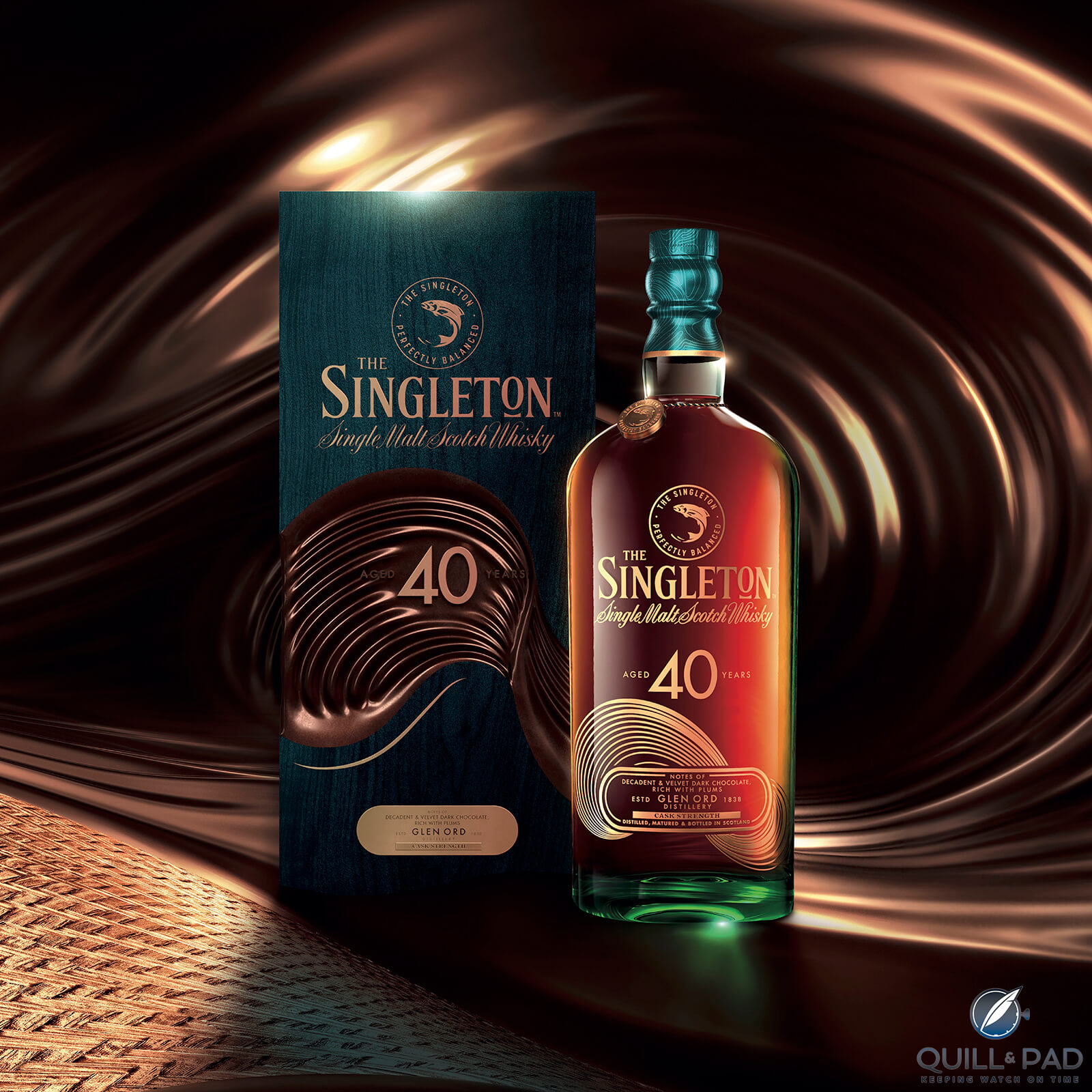
The Singleton 40-Year-Old Malt Whisky
Singleton is an interesting distillery as it is basically a distillery within a distillery.
We need to go back to 1838 for the origins of this story, but first, those based in America or Europe may be puzzled by the name. Singleton is a distillery that has, so far, focused largely on the Asian and Australian markets. Americans and Europeans should look to the Glen Ord Distillery, which is basically home to Singleton.
Glen Ord is a distillery founded in the Scottish Highlands back in 1838. It is the only remaining single malt distillery found on Black Isle (which all sounds very Robert Louis Stevenson). Black Isle is not, however, an island at all, but rather a peninsula located in the western part of Scotland. The lands were originally granted to the MacKenzies of Ord in the 13th century by King Alexander III.
If one may digress briefly, Alexander seems to have been one of the more interesting monarchs of the age. After the death of his father, Alexander II, Alexander III was coronated at the age of 7 (never a promising indication of longevity for any monarch in past eras to ascend to power at such a young age).
Despite power struggles, he managed to survive and married an older woman, Margaret, daughter of King Henry III of England – she was eleven and he was ten. Margaret died while still young but managed to provide Alexander with three children, none of whom outlived him. At the wedding, his father-in-law took the opportunity to demand homage from the ten-year-old. Alexander refused. One brave ten-year-old. In later years, Alexander’s maneuvering managed to recover the Western Isles and the Isle of Man from Norway for Scotland.
After the death of his wife and children, Alexander did his best to sire a male heir, becoming well known as the bane of local nuns, virgins and widows. Eventually, he died when he fell from his horse during a storm one evening when on the way to visit his second wife. She was pregnant, but sadly the child was stillborn and thus the new heir was to be his granddaughter, Margaret, Maid of Norway (daughter of his deceased eldest daughter and the King of Norway), who was three.
Her father refused to allow her to travel to Scotland until he believed it safe. When she was seven, she set forth but died from food poisoning on the trip (allegedly) and so was never inaugurated. At this stage, no less than 13 contenders for the throne stuck up their hand. In the midst of this chaos, England decided it had seen enough and war ensued.
All of which is largely irrelevant to our whisky.
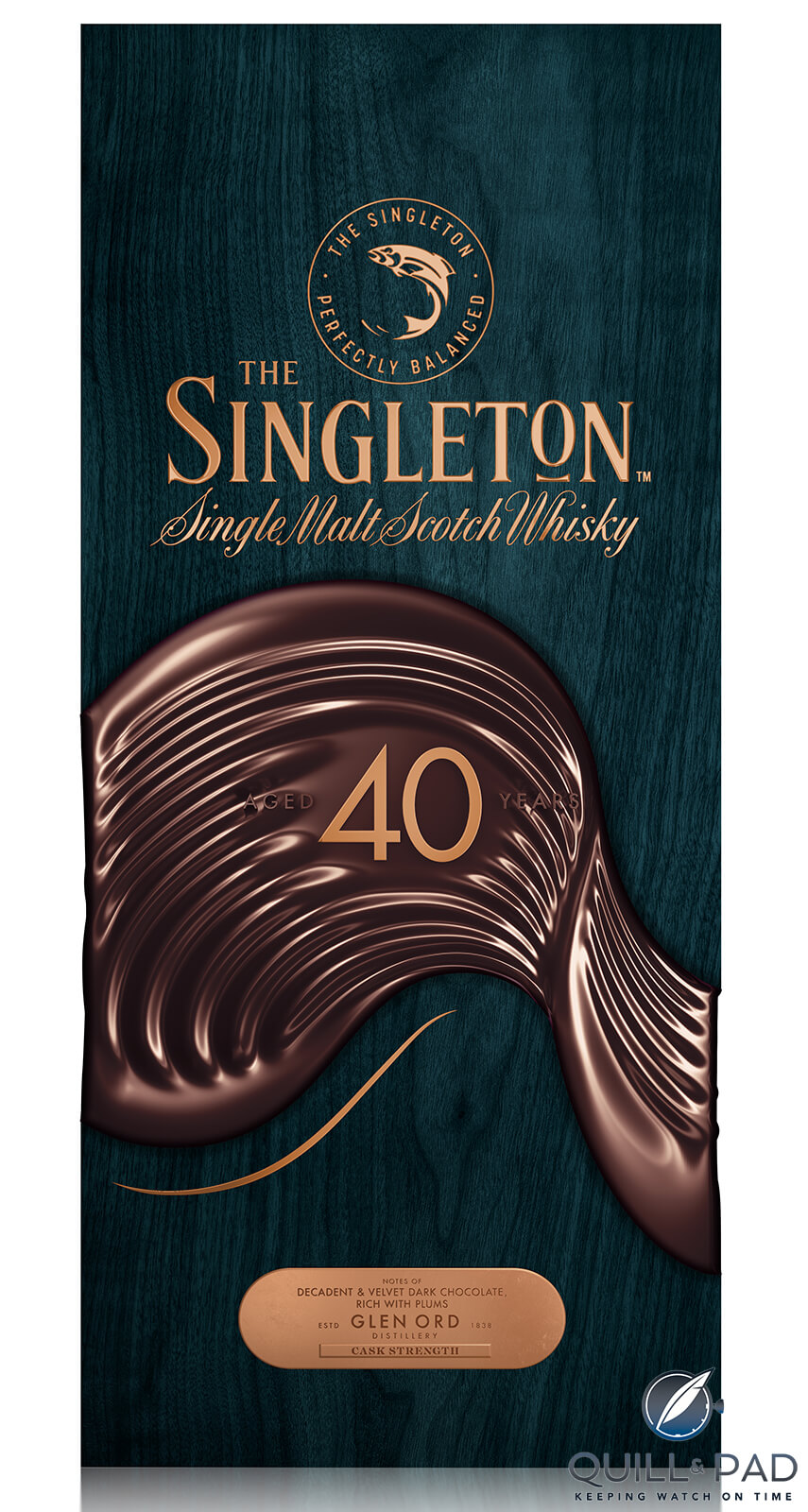
The Singleton 40-Year-Old Malt Whisky
If we fast forward to 1820, Thomas MacKenzie of Ord inherited the estate and decided that it was time to develop the region. As his holdings grew a large amount of barley, he leased land to allow the construction of a distillery. There were already nine competing distilleries operating on Black Isle. The new one was originally called the Ord Distillery, later becoming the Glen Ord Distillery, and was founded in 1838.
By 1847, the license holders were bankrupt, but a little thing like no legal license was never going to stop the operation of the distillery (I believe that the official version is that the distillery lay dormant during this period, though other reports suggest no such thing). By 1855, the license was granted to new owners Alexander McLennan and Thomas McGregor.
McLennan passed away in 1870, whereupon his widow married Alexander MacKenzie, a bank clerk, who took over the distillery. By now, they were selling Glen Ord throughout the British Colonies. McKenzie placed his mark on the operation by constructing a series of new buildings. Sadly, a few years later, they all burnt down. Around this time, the distillery started selling their whiskies under other names – a forerunner to Singleton – including Glen Oran.
By the end of the century, the operation had been sold to James Watson & Son, whisky blenders of Dundee, for the hefty sum of £15,800. World War I saw the distillery closed – the government decreed that barley was needed for food, not fermentation. They reopened in 1919 but sold to Thomas Dewars & Sons of Perth. World War II caused another closure.
Again, they reopened after the War, in 1946. Over the years, various corporate two-steps finally saw the distillery form part of the portfolio of Diageo. It had gained a reputation for technical advances such as the biobed modular plant technology to treat wastewater with low chemical oxygen demand loads (the first company in the UK to adopt such technology).
Today, the Glen Ord distillery produces whisky for various Diageo products, not least for the Johnnie Walker and Dewar blends. In addition, and relevant to us, they produce the Singleton series (the way that Diageo operates means that they are able to incorporate contributions from other distilleries to certain products if they feel that this will improve the product).
They also release Douglas Laing whiskies and various independent bottlings. To cope with all this, improvements were made to the distillery in 2014/2015, double capacity and including additional stills. The water in use is sourced from Loch nam-Bannach and Loch nam Euan.
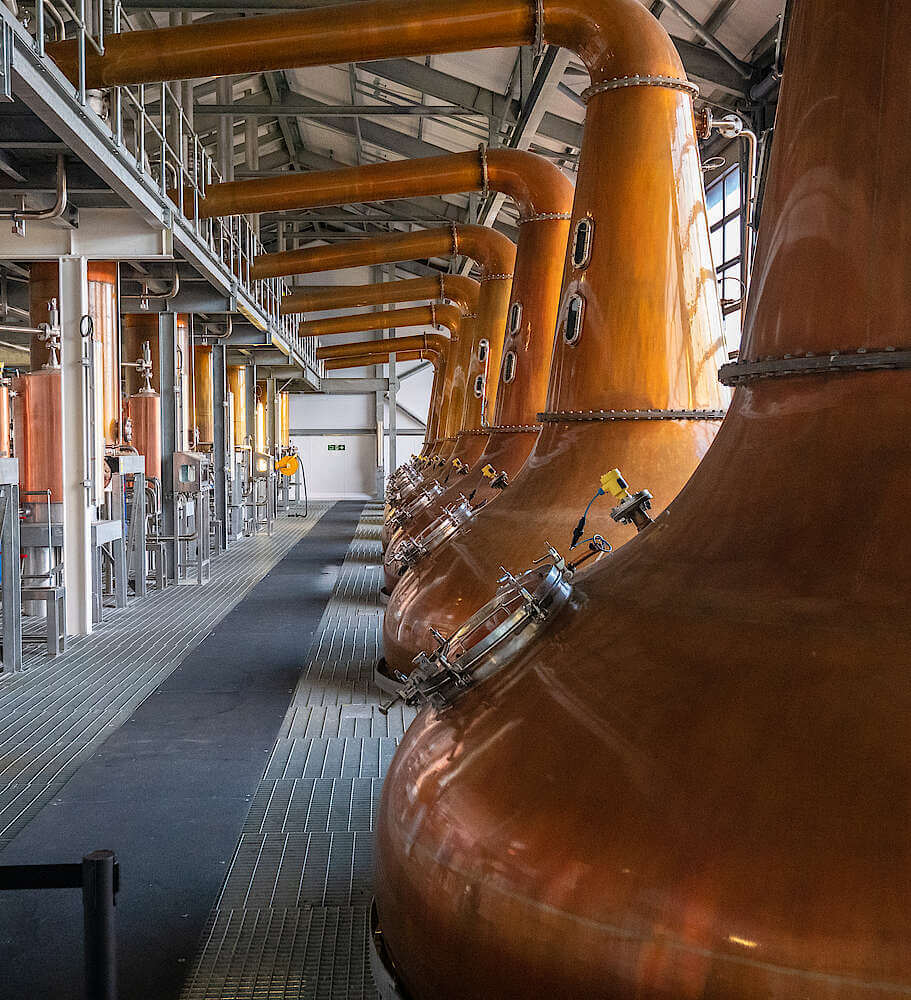
Copper pot stills at the Glen Ord distillery (photo courtesy www.whisky.com)
Distillation here is based on the onion-shaped copper pot stills at a lower temperature than is seen at many distilleries. They aim for a longer distillation which they believe assists in removing impurities from the final whiskies. Casks are mostly American oak ex-Bourbon, with a smaller contribution from ex-Sherry casks. Current annual output is an impressive 12 million liters (or five million liters according to conflicting sources – either way, it is a lot of whisky, and it is no surprise that it is Diageo’s fourth largest distillery in Scotland).
Since 1966, they have operated with six pot stills, three wash stills and three spirit stills (prior to 1966, there were just two stills). Each of the three wash stills have a capacity of 17,000 liters, while the spirit stills are a little smaller – 16,000 liters. The new still house, completed in 2015, provides a further eight stills, four wash (16,000 liters) and four spirit (14,000 liters) stills.
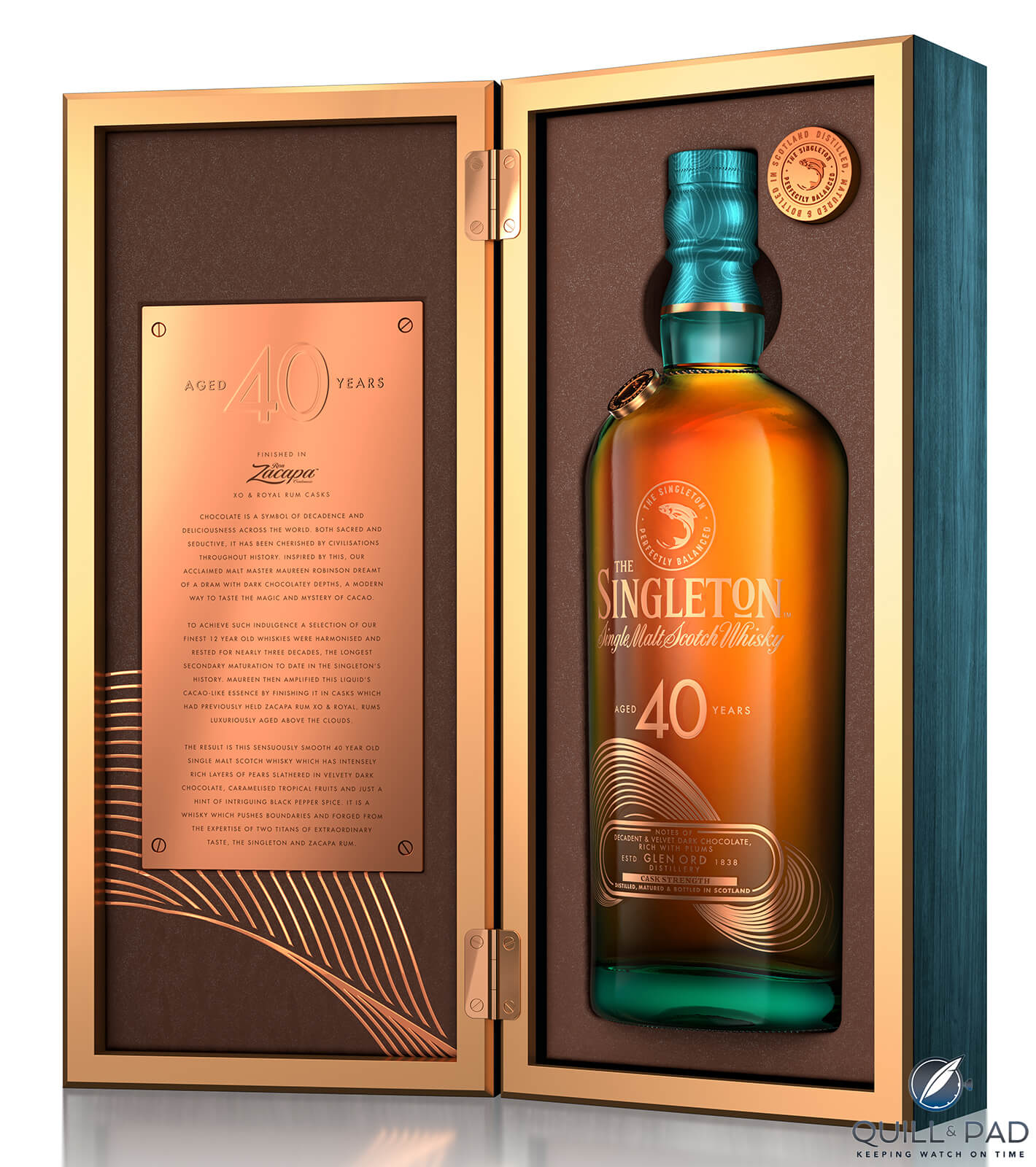
The Singleton 40-Year-Old Malt Whisky
The Black Isle is famous for first-class barley, hence the reason that the Glen Ord distillery still possesses on-site maltings, while also producing malt for some of the other Diageo distilleries, such as Talisker, Clynelish and Brora. The malt used here is unpeated.
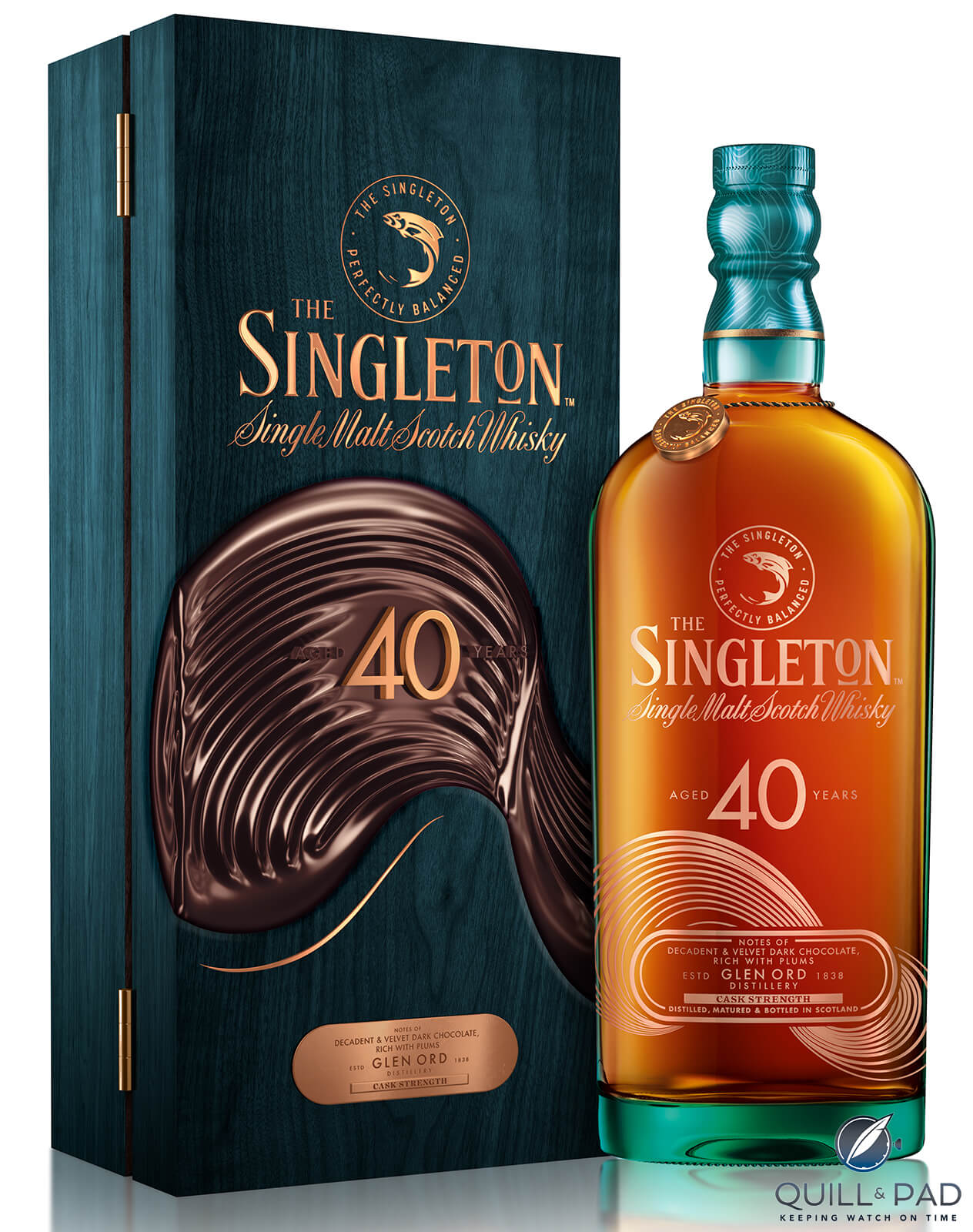
The Singleton 40-Year-Old Malt Whisky
Singleton offers 12-Year-Old, 15-Year-Old and 18-Year-Old malts, but also very limited bottlings of much older whiskies. The latest is the 40-Year-Old (A$5,940/US$3,755 excluding duty and taxes/£3,300). From their original 12-Year-Old malts, it had an extensive ‘secondary maturation’ of 28 years in a combination of former rum, bourbon, Pedro Ximénez and oloroso sherry casks before the final finish in ex-solera casks that previously housed Zacapa XO and Zacapa Royal rums.
It is part of what Singleton term the Epicurean Odyssey Series – Malt Master for Singleton, Maureen Robinson, has said, about the series, “I am in a privileged position to be able to use the skills I’ve acquired over my more than forty years at Diageo and apply them to experiment with flavor; something The Singleton gives me the freedom to do.” The aim of the team with this 40-Year-Old was to make the most indulgent whisky they could.
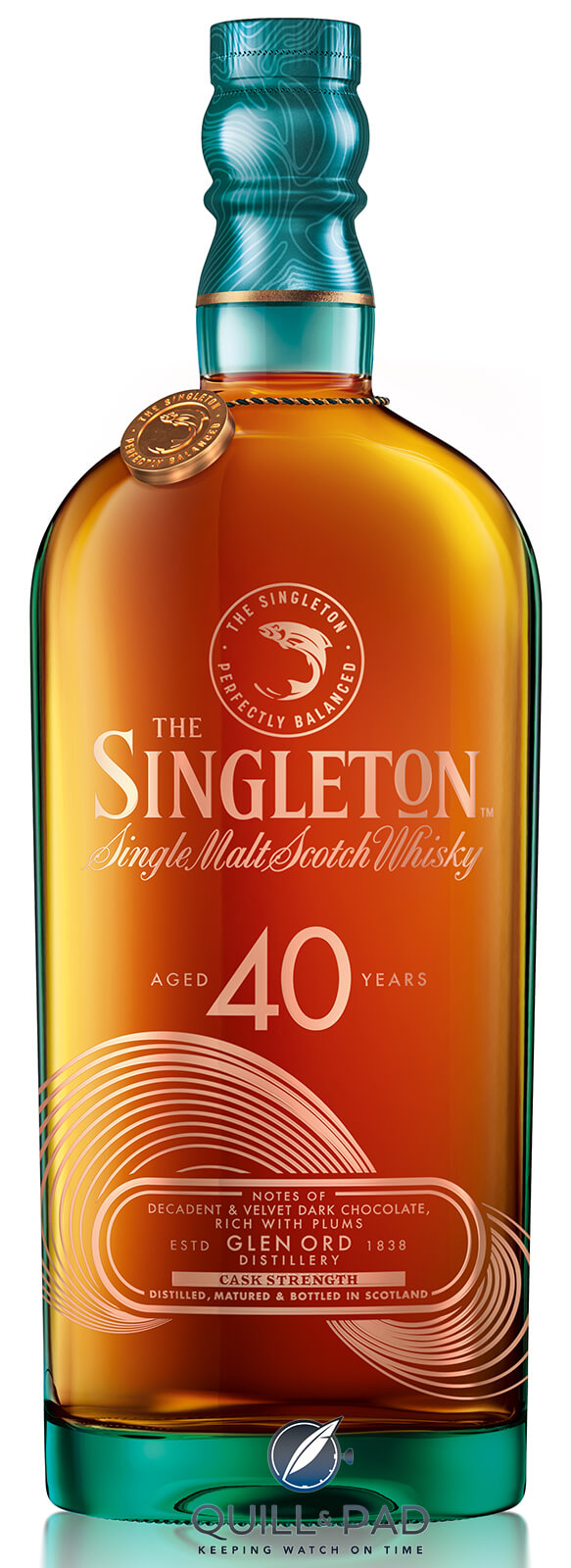
The Singleton 40-Year-Old Malt Whisky
There are just 1,716 bottles available worldwide. This is a cask strength whisky at 45.9% ABV (something I know will please some readers), although notwithstanding the advice quoting that figure regularly, my bottle actually noted the alcohol at 55.4%. In recent years, they have also released a 38-Year-Old and a 39-Year-Old malt. This 40-Year-Old is the third and final release in the series.
Tasting notes – The color is glorious bronze gold. The nose is wonderfully decadent, rich and complex. There are flavors weaving through dark chocolate, stewed peaches, honeycomb, spices, black cherries and ripe tropical notes. A very gentle whiff of smoke and toffee entwined. Finishes with caramel, glacéd pineapple and a hint of chocolate biscuits. Alluringly mellow but with undoubted power, there is amazing length. If a hedonistic malt is your thing, then you will find this a majestic malt.
For more information, please visit https://www.thesingleton.com/about
You might also enjoy:
Chivas Regal Ultis XX: A Blended Whisky to Rival Great Single Malts
Alberta Premium Cask Strength Rye: World’s Best Whisky Of The Year 2021, But Opinions Are Divided
Glenfarclas 50-Year-Old Malt Whisky: There’s No Substitute For Time
Lark Rare Cask Series Para100 Whisky: Yes, Tasmania Makes World-Class Whisky
Yamazaki 12-Year-Old Japanese Whisky: Why Pricing Has Gone Through The Roof
Leave a Reply
Want to join the discussion?Feel free to contribute!



46% is “cask strength”?
Absolutely not.
It’s a good strength, my ideal as I stated in a previous article (although since tasting Corryvrekan at 57%, my opinion may be changing. 😊)
But this is typical nonsense from Diageo.
I’m sure it’s very nice. But these days its vitally important to know the state of the casks. I just bought a Glendronach that wouldn’t have been given to the dogs twenty years ago. The reason? Third, fourth, even fifth fill casks!
If possible, I would ask for this information
Hi Tam. I can’t comment on the Glendronach but I have further info which might help clarify things. Apparently, there are two versions. Although I must say I have no idea why.
I will just digress to say that from my position, Diageo tend to be one of the more supportive and helpful entities in the world of alcohol. I can assure you many are far worse. That said, they did not really make this clear – or more likely, I missed it.
The two versions are a cask strength one pushing 55% and the more standard one at 46%. While it is the more standard version that is on sale downunder, it was the cask strength (55%) version which I have reviewed. My apologies for any confusion I may have caused. Anyone purchasing a bottle would be wise to check, and purchase according to their preference.
I am now 89 and have been a Singleton man for over 40 years, perhaps longer. A wee dram, often more, is a very satisfying and quiet time for me. I have not been in Scotland for several years, however, I enjoy the things of old and where ever I wander where ever I roam SCOTLAND for ever will be my home.
Hi Leslie, thanks so much for your thoughts. I must confess that it is a while since I have been in Scotland (Scottish heritage on my father’s side), but hopefully that will be rectified before too long. Here’s to you enjoying that dram of Singleton for many more years.